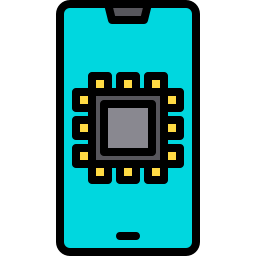
System on Chip (SoC) in Mobile Phone Hardware Components
A System on Chip, often called SoC, is the core hardware platform that drives modern smartphones. It combines several essential electronic components into one integrated circuit, reducing size, power consumption, and cost while boosting performance. In mobile devices, SoC is designed to handle everything from processing data and running apps to managing connectivity and multimedia functions. Unlike traditional setups where each component was a separate chip, an SoC consolidates them into one unit, making it the “brain and nervous system” of the phone.
Main hardware components inside an SoC include:
Central Processing Unit (CPU)
The CPU is responsible for handling instructions, running operating systems, and managing applications. In mobile SoCs, CPUs are typically multi-core with energy-efficient designs, balancing speed and battery life.Graphics Processing Unit (GPU)
The GPU handles graphics rendering for user interfaces, gaming, and video playback. In smartphones, GPUs are optimized for high performance while keeping heat and power usage under control.Memory Controller
The SoC contains controllers to manage RAM and storage access. This allows for quick data transfers between applications and hardware, which is essential for multitasking and performance.Digital Signal Processor (DSP)
The DSP manages audio, image, and video processing. It is particularly important for voice recognition, camera functions, and real-time media tasks where speed and accuracy are required.Image Signal Processor (ISP)
The ISP processes data from the phone’s camera sensors. It handles tasks such as autofocus, noise reduction, and color correction, enabling higher-quality photos and videos directly from the hardware.Modem and Connectivity Units
Modern SoCs integrate 4G, 5G, Wi-Fi, Bluetooth, and GPS modules. This reduces the need for external chips and helps improve efficiency and reliability in wireless communication.Neural Processing Unit (NPU) or AI Engine
Many advanced SoCs feature NPUs for artificial intelligence and machine learning tasks. They support face recognition, voice assistants, and real-time language translation, all executed locally on the device.Power Management System
The SoC integrates specialized circuits to optimize energy usage. By intelligently distributing tasks across CPU cores, GPU, and DSP, it extends battery life without compromising performance.Security Modules
SoCs often include secure enclaves or trusted execution environments. These protect sensitive data such as biometric information, payment credentials, and encryption keys at the hardware level.
Applications of SoC in smartphones include efficient multitasking, high-quality mobile photography, immersive gaming, secure online transactions, and seamless wireless communication. They also allow thinner and lighter phone designs since fewer separate chips are required.
When it comes to availability, SoCs are not free. They are commercial hardware products developed by companies such as Qualcomm, Apple, MediaTek, Samsung, and Huawei. Each company designs proprietary SoCs with unique optimizations, and these are sold to smartphone manufacturers or used exclusively in their own devices. Users cannot access or download SoCs independently; they are embedded in the hardware from the start.
Comparing SoCs with traditional multi-chip setups shows clear advantages. They are smaller, more energy-efficient, and more powerful since all major components are on one integrated circuit. However, they are also less flexible because users cannot easily replace or upgrade individual parts. For example, if you wanted a faster GPU, you cannot swap it in separately since it is already built into the SoC. This trade-off is accepted because mobile devices prioritize compactness and efficiency over modularity.
Conclusion
The System on Chip is the foundation of modern mobile phone hardware, combining multiple critical components into one integrated solution. It ensures that smartphones can deliver high performance, strong connectivity, advanced multimedia, and secure user experiences in a compact and power-efficient form. While not free and only available through manufacturers, SoCs provide unmatched value by enabling features and performance levels that would not be possible with separate hardware chips. Their integration defines the direction of mobile technology and continues to shape the evolution of smartphones.












